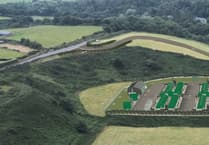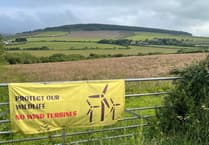An estimated £100m will need to be spent on a new power interconnector between the Isle of Man and the UK if the island is to meet its net zero ambitions, according to the Treasury Minister.
The government’s target is to ensure 75% of the island’s electricity is generated from renewable sources by 2035 and to achieve net zero emissions by 2050.
This week marks the 25th anniversary of the existing subsea electric interconnector between the island and the UK.
A government document on future energy scenarios describes a back up new interconnector as a ‘no regret solution’ and the most cost-effective way of balancing, and providing resilience to, the island’s energy supply.
Treasury Minister Dr Alex Allinson said that a new interconnector was vital to meet the expected exponential increase in demand for electric vehicles and heat pumps as part of the island’s transition to renewables - and this could cost £100m at a rough estimate.
He said: ‘The interconnector has played a crucial role in both importing and exporting electricity between the Isle of Man and the UK . It has significantly reduced the Isle of Man's dependence on local diesel-powered generation. Additionally, the cable is bundled with a fibre-optic cable used for telecommunications.
‘Professor Curran’s 2019 report highlighted that the interconnector alone would not have sufficient capacity to supply extra electricity to the island anticipated by the increased use of electric vehicles and air-source heat pumps.
‘Strengthening the existing grid and establishing another interconnector for import and export of electricity are seen as essential longer term priorities by MUA.
‘However, there have been increased supply chain costs and so work is currently underway to accurately cost a range of options that will help maintain the reliability of our power supply as well as strengthen energy security.’
A spokesperson for Manx Utilities said that a feasibility assessment into the cost and delivery of a second interconnector, as outlined in the Island Plan, is ongoing.
The existing submarine AC power cable came online in 2000 and runs 104 km (65 miles) under the Irish Sea between Port Skillion below Douglas Head and Bispham on the Fylde coast, connecting the Isle of Man's transmission system to the UK's. It has a capacity of 60MW. The average electricity demand across the island is currently about 40MW.
Total cost of the project was around £50m.
A UK study estimates the cost of a new interconnector as being between Euro 2-4 million per GW or Km, based on 2016 figures.
The 2021 report on future energy scenarios said: ‘Balancing the Isle of Man’s electricity network requires stabilising power; this cannot be provided from sources which are reliant on the weather to produce electricity as these sources cannot be guaranteed at all times.
‘In all scenarios the most cost-effective solution of providing this stabilising power is a new interconnector to the UK. Regardless of which future energy scenario is identified as the best pathway to net zero, an interconnector will be required; it is therefore a no regret solution.’
Whether or not the island moves away from using natural gas to generate electricity, significant investment will still be required, with existing power stations requiring replacement in the next 10 to 15 years, the gas turbine power station at Pulrose reaching the end of its design life by 2035.

The 2021 document said economic modelling shows that the cost of generating on island from renewables is more expensive than importing power. Costs have escalated since then.
It said continuing to rely on fossil fuels would cost £996 per household per year but most renewable energy scenarios, all featuring interconnectors as well as biomass generation and varying proportions of solar and wind power, would cost more, and in some cases much more.
One option was cheaper, at £820 per household. This would see 50% of new builds having roof-top solar panels, giving a capacity of 2.3 MW, with an additional 6 MW of solar installed on public buildings and small-scale community wind projects providing 2 MW total power.
Diesel generators would be replaced with a 140MW interconnector, with biomass increasing to phase out the gas turbine power station in the early 2030s and the existing 60MW interconnector re-conditioned to extend its life.
Professor James Curran’s 2019 report on actions needed to achieve net zero by 2050 notes: ‘The interconnector is used to import electricity and therefore decarbonisation could potentially be achieved by the Isle of Man becoming a net importer of energy.
‘However, based on current consumption, the capacity of the interconnect would not be able to service the current peak electrical demand so existing generation assets would be required particularly if the anticipated future take up of electric vehicles and air-source heart pumps occurred.’




